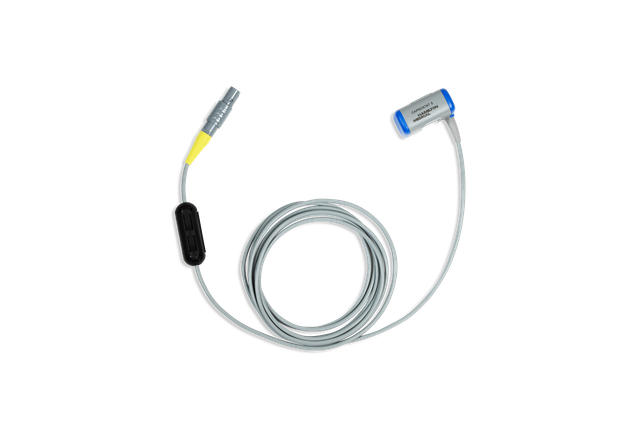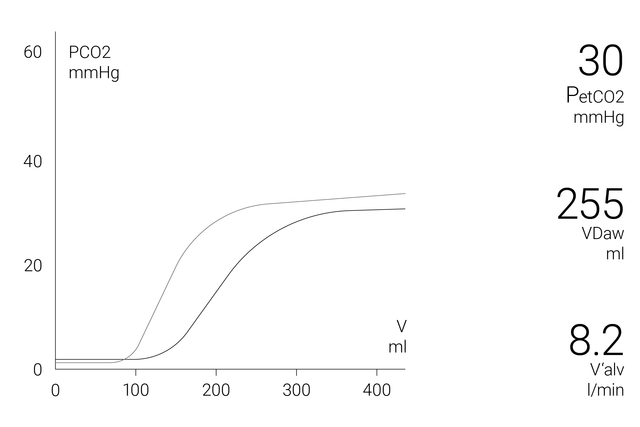
For more insights. Volumetric CO2 monitoring
The phases of a volumetric capnogram, the shape and curve morphology, and measurements based on calculations derived from it can tell you an important story about:
- Ventilation‑perfusion efficiency
- Physiologic dead‑space fraction
- Patient's metabolic rate (
Jaffe MB. Using the features of the time and volumetric capnogram for classification and prediction. J Clin Monit Comput. 2017;31(1):19‑41. doi:10.1007/s10877‑016‑9830‑z1 )

A powerful tool. The CO2 sensor
On our ventilators, CO2 is measured with a CAPNOSTAT‑5 mainstream CO2 sensor proximal to the patient's airway.
The CAPNOSTAT‑5 sensor gives you precise measurements of end‑tidal carbon dioxide (PetCO2), and a clear, accurate capnogram at all respiratory rates of up to 150 breaths per minute.

Little sensor, big data. This is what you get
The volumetric capnogram window on the display shows exact quantitative information as a combination of proximal flow and proximal CO2 data such as:
- Current volumetric capnogram curve
- Volumetric capnogram reference curve
- Reference curve button with time and date of reference loop
- Most relevant CO2 values, breath by breath
To allow a more comprehensive analysis of the patient condition, a 72‑hour trend (or 96‑hour with HAMILTON‑G5/S1) is available for:
- PetCO2
- V‘CO2
- FetCO2
- VeCO2
- ViCO2
- Vtalv
- V'alv
- VDaw
- VD/Vt
- VDaw/VTE
- Slope CO2
To make your life easier, Hamilton Medical ventilators offer an overview of all relevant CO2‑related values in the Monitoring CO2 window.
- Fractional end‑tidal CO2 concentration: FetCO2 (%)
- End‑tidal CO2 pressure: PetCO2 (mmHg)
- Slope of the alveolar plateau on the PetCO2 curve, indicating the volume/flow status of the lungs: slopeCO2 (%CO2/l)
- Alveolar tidal ventilation: Vtalv (ml)
- Alveolar minute ventilation: V’alv (l/min)
- CO2 elimination: V’CO2 (ml/min)
- Airway dead space: VDaw (ml)
- Airway dead‑space fraction at the airway opening: VDaw/VTE (%)
- Exhaled CO2 volume: VeCO2 (ml)
- Inspired CO2 volume: ViCO2 (ml)
See it with your own eyes. Book a free personal demonstration or schedule a callback
Let us guide you through all the benefits of volumetric capnography, and see it directly in action. Book a free personal demonstration with one of our specialists:





